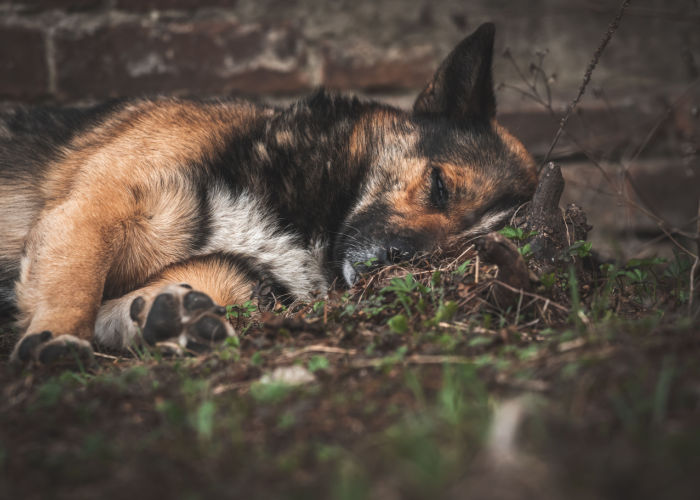Dying dog signs may vary, but fur parents feel the same heartbreak and pain seeing their pup fight for its life.
As much as we’d want to, our dogs may not live longer than us.
Regardless, the quality of time you spend with your furry one matters the most.
We know how difficult this time can be.
And at Top Dog Tips, we’re committed to sharing with you every vital information you need to know.
In today’s article, we’ll be discussing heartbreaking signs your dog is dying and some tips to help you deal with the pain.
Dying Dog Signs: 21 Things You Need To Know
Saying goodbye to your dog is one of the hardest steps to do. Yet, it’s important to be aware of the signs to help you make sound decisions.
Here are some signs that your pup is nearing the end of its life:
Common Dying Dog Signs
1. Loss of Appetite
Loss of appetite is one of the most common dying dog signs. You may observe sudden changes in their appetite, such as:
- Time
- Amount
- Frequency
- Eagerness
However, your pooch’s loss of appetite shouldn’t be immediately attributed as a sign of death because dogs who are unwell or sick may also show the same sign.
Nevertheless, this is something to look out for, especially when your furry one is about to cross the rainbow bridge.
2. Weight Loss
When your dog loses their appetite, it’ll automatically reduce in weight. This could also be due to changes in their metabolism or digestive processes.
While this may get difficult to avoid, you can gently encourage your pup to eat whenever you can.
Tip: You can try to offer them their favorite treats or food to ignite their interest to eat.
3. Pain and Discomfort
Unfortunately, it’s difficult to identify what dying dogs are feeling inside or the pain they endure.
As a result, dogs may show uneasiness or weird behaviors.
Despite this inevitable situation, it’s best to let them feel that they’re not neglected.
Tip: You can give them their favorite bed, toy, or space to rest comfortably.
4. Uncontrollable Urge To Pee or Poop
When your dog’s body organs start shutting down, it can no longer control when and where to pee or poop.
The best thing to do at this point is to clean their dirt right away.
It's also best to keep your dog’s space clean and dry at all times.
5. Body Odor
When your dog is dying, you may notice a strong or foul body odor coming from them.
This happens due to the following:
- Fur oil-buildup
- Less grooming
- Body organ failure
- Changes in metabolism
- Poop or pee residue on their fur
When this occurs, you may try the following tips to keep them clean:
- Clean their space or favorite spot
- Wash their bedding and toys from time to time
- Wipe your pooch’s face with a soft, damp towel
- Give their fur a gentle brush or use a dry shampoo
Note: Pay attention to their body temperature or behavior before grooming your pooch.
6. Dull Eyes
Dull eyes are a common sign of old age in dogs. However, this can also be attributed as a signal when your dog is dying.
That said, you may notice the following conditions in your dog’s eyes:
- Cloudy
- Troubled eyesight
- Weary or drooping
7. Body Temperature
When your dog is dying, you may notice temperature changes in its body.
They'll start to feel cold or warm in a matter of time due to organ failure in the body. As a result, your dog experiences difficulty in regulating their temperature.
So, it’s best to give your pup a comfy space to rest and take note of their body temperature regularly.
8. Weakness
Dying dogs lie in an unusual spot or space at home and in the same spot for longer periods at times.
Lethargy or extreme weakness can also be attributed to when a dog is sick.
However, a prolonged period of your furry one’s alone time is already a warning sign.
9. Loss of Interest
When dogs are dying, they’ll show little to no interest in any physical activity anymore.
You may notice your dog ignoring or barely acknowledging you or your family members, even their favorite toys and other pets at home.
They’ll start to act differently than they used to. Unfortunately, this could be your dog’s way of telling you they’ll be gone soon.
10. Poor Grooming
Dying dogs generally lose their energy as time passes by.
As a result, they’ll stop grooming themselves, too. Your dog’s coat will begin to feel or look dry and unkempt.
This is common when their bodies begin to deteriorate.
11. Breathing Problems
Breathing difficulty is a major symptom of an illness or pain in your dogs.
However, this could also be another warning that your pup’s life is nearing an end.
You may notice your dog breathing either slowly or rapidly. At times, they may also breathe loudly or quietly.
This happens when your dog is having difficulty moving air in and out normally.
Unfortunately, this is one of the last things to happen before your dog dies.
12. Loss of coordination
Followed by deteriorating eyesight, dying dogs usually get clumsier than usual.
Loss of coordination or movement in dying dogs can also be associated with dehydration.
This occurs when your pup no longer eats food or drinks water or when they completely cut down their source of nutrition.
13. Changes in gum color
When your dog’s organs are failing, one thing you may notice is when their gums turn blueish.
This means that there’s an insufficient amount of oxygen in their system.
Unfortunately, this could also be an indication of your dog bidding its last goodbye.
Note: White or pale gums are often associated with insufficient or abnormal blood flow, while bright red gums indicate that your dog is suffering from heat stroke.
Severe Dying Dog Signs
14. Vomiting
Vomiting is a common reaction when dogs are sick or have eaten something bad.
But in some cases, dogs also vomit when they’re dying, especially when they’re forced to eat or take medicine.
This happens when their digestive system no longer functions normally. Their bodies begin to reject food or anything they ingest.
15. Diarrhea
In addition to vomiting, dogs may also experience diarrhea when they’re dying.
This is a result of the failing organs in the body, especially the digestive tract.
16. Seizures
Dogs experience muscle twitching or spasms as they grow old or during an illness and pain.
However, seizures or severe twitching can also be a sign your dog is dying and could be due to the following conditions:
- Organ failure
- Metabolic changes
- Brain dysfunctions
Dying Dog Signs and Its Psychological Effects
17. Depression
In general, depression in dogs could be due to the following reasons:
- Trauma
- Boredom
- Rehoming
- Social isolation
- New companions
- Sickness or injury
Meanwhile, dogs get depressed when they’re dying, too.
Note: Dogs aren’t necessarily aware of their depression, but it’s a psychological result of their condition.
18. Anxiety and Confusion
In addition, dying dogs may experience anxiety and confusion along the way.
In some cases, you may notice the following reactions from your dogs when they’re anxious or confused:
- Crying
- Pacing
- Panting
- Whining
You may also notice your dogs wandering in the house or in the backyard, looking lost and clueless.
Furthermore, a study claims that dogs who are extremely attached to their owners show separation anxiety, especially when their owners are away.
So, it’s best to be with them at these trying times whenever you can to help reduce the feeling of loneliness.
19. Irritability or Aggression
Dying dogs feel unwell, and they’ll usually become disinterested in almost anything.
However, pay attention and always be careful when your dying dog disassociates from you.
They could show aggressive behavior or irritability when you intrude on their space.
While you want to comfort them at their worst, be mindful of their body language at all times.
20. Clinginess
Dogs act differently, especially when they’re dying.
In some cases, they’ll seek comfort from your presence and even follow you all the time.
As heartbreaking as this may sound, dogs seem to comfort their fur parents even when they’re trying to say goodbye.
21. Emotional Detachment
In contrast to the previous item, dogs can shut you down completely or hide from you when they’re dying.
In most cases, dying dogs seek solitude by wanting to spend time by themselves in an unusual spot at home.
The best thing you can do at this point is to still provide them the comfort they need by:
- Putting their favorite toys near them
- Assuring their space is clean and dry
- Supplying them with some fresh water
- Putting a bowl of their favorite treats or food
How To Comfort a Dying Dog
The death of a furry one is an inevitable circumstance.
However, it’s not too late to make them feel loved, even at this painful moment in their lives and with their owners.
Here are some meaningful ways to comfort a dying dog:
Staying Close To Them
Dogs behave differently when they’re dying.
Some dogs show their affection and seek comfort from their owners, while some prefer to distance themselves.
Whenever you can, try to show them that you’re there for them.
You can try the following tips to comfort your pups:
- Pet them gently
- Sit next to them
- Talk to them in a soothing, calming tone
Respect Their Space
In some cases, dying dogs prefer to be alone.
Avoid introducing strangers or animals to them as much as possible. Chances are, dying dogs can also show signs of depression and anxiety.
They may also show irritability when they’re dealing with pain and discomfort.
Seek Your Vet’s Help
As a general rule of thumb, pet owners should avoid second guesses or personal instincts whenever they can.
Always seek your professional vet for advice, especially at this stage in your dog’s life.
Heartwarming Ways To Keep Your Dog’s Memories Alive
While this is rather a difficult time for pup parents, it at least serves as a daily reminder for you to cherish all the time you have now with your fur buddy.
So, here are a few ways to keep your memories together while you still can.
1. Take Pictures and Videos
And lots of it.
Make the time stand still, click that camera, and pose with your pup.
You can record videos on special occasions, such as:
- Camping
- Beach trips
- Birthday parties
- Pup cup trips at Starbucks
Of course, you can always document your time together, even if your pooch is napping or chilling in the backyard.
You can create a photo album or put your pictures in a frame. Be sure to save all your snapshots on your phone or computer as a backup.
2. Pet Keychains
Nothing beats a stressful day than a smiling photo of your pooch hanging from your desk.
You can also have a gorgeous photo of your pup along with your car keys while driving in a terrible traffic jam.
It’s safe to say that dogs give us that extra therapeutic effect we need.
That said, you can try to customize a lovely keychain with a photo of your pup printed on it.
Choose the best photo you can find and make it a valuable accessory anywhere you go.
3. Customize Your Stuff with Your Dog’s Photo
From shirts to pillows, you can print your fur baby’s photos even on your favorite mug.
Interestingly, you can create a needle-felted portrait of your furry one, too.
Tip: DIY artists from online platforms like Etsy can help you transform your pup's photo into a realistic one through needle-felting.
Meanwhile, others claim that realistic pet portraits hinder you from moving on from a painful loss.
But it’s always best to evaluate yourself first before deciding how much you can handle.
In a positive light, many fur parents turn these memories into inspiration and joy despite the pain.
4. Keep a Core Memory in One Frame
You can create a DIY frame with your pup’s collar, or you can try this keepsake frame and customize it with a picture of you and your dog.
5. Clay Pawprints
Hand-casting kits are popular with couples, friends, and families. But you can also try to print your pup’s paw using clay and frame it.
Clay paw printing is a heartwarming way to preserve your fur buddy’s memory at home.
Definitely, this deserves a spot in your living room or bedroom.
Dying Dog Signs: FAQs
What happens in the last hours of a dog's life?
Dying dogs in their last hours may show extreme weakness, breathing difficulty, and muscle twitching.
Their skin may start to look pale due to dehydration and loss of oxygen in the body. Also, they may no longer make movements, such as standing up or walking.
How long do dying dog signs show?
The dying dog signs can take effect immediately in cases of severe illness or injury. However, there is no definite timeline for when dogs show dying symptoms.
In some cases, it can take weeks or longer before you start noticing signs your dog is dying.
Dying Dog Signs: Final Thoughts
Identifying these dying dog signs can be best consulted with your vet for accurate findings and medication.
We recommend immediately seeking professional help when these symptoms show in your pups.
It’s also important to note that dog end-of-life signs can vary from a lot of factors, including old age, breed, illness, or injury.
Indeed, death in pets is uncontrollable. However, this reality poses a strong message to fur parents out there to make the most of your time with your pups while you can.


















